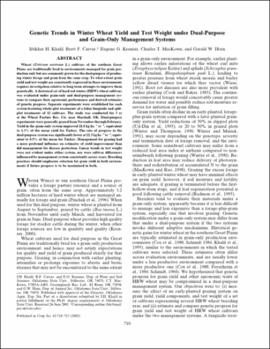| dc.contributor.author | Khalil, Iftikhar H. | |
| dc.contributor.author | Carver, Brett F. | |
| dc.contributor.author | Krenzer, Eugene G. | |
| dc.contributor.author | MacKown, Charles T. | |
| dc.contributor.author | Horn, Gerald W. | |
| dc.date.accessioned | 2015-10-16T20:47:50Z | |
| dc.date.available | 2015-10-16T20:47:50Z | |
| dc.date.issued | 2002-05 | |
| dc.identifier | okds_Carver_CS_2002-05.pdf | |
| dc.identifier.citation | Khalil, I. H., Carver, B. F., Krenzer, E. G., MacKown, C. T., & Horn, G. W. (2002). Genetic trends in winter wheat yield and test weight under dual-purpose and grain-only management systems. Crop Science, 42(3), 710-715. https://doi.org/10.2135/cropsci2002.7100 | |
| dc.identifier.uri | https://hdl.handle.net/11244/19798 | |
| dc.description.abstract | Wheat (Triticum aestivum L.) cultivars of the southern Great Plains are traditionally bred in environments managed for grain production only but are commonly grown for the dual-purpose of producing winter forage and grain from the same crop. To what extent grain yield and test weight are consistently expressed in those environments requires investigation relative to long-term attempts to improve them genetically. A historical set of hard red winter (HRW) wheat cultivars was evaluated under grain-only and dual-purpose management systems to compare their agronomic performance and derived estimates of genetic progress. Separate experiments were established for each system featuring whole-plot treatments of a foliar fungicide and split-plot treatments of 12 cultivars. The study was conducted for 3 yr at the Wheat Pasture Res. Ctr. near Marshall, OK. Dual-purpose experiments were generally grazed from November through February. Yield in the grain-only system improved 18.8 kg ha^-1 yr^-1, equivalent to 1.3% of the mean yield for Turkey. The rate of progress in the dual-purpose system was significantly lower at 11.3 kg ha^-1 yr^-1, equivalent to 0.9% of the mean for Turkey. Management for grazing had a more profound influence on estimates of yield improvement than did management for disease protection. Linear trends in test weight were not evident under either system, nor were cultivar differences influenced by management system consistently across years. Breeding practices should emphasize selection for grain yield in both environments if future progress is to be maximized in both. | |
| dc.format | application/pdf | |
| dc.language | en_US | |
| dc.publisher | Crop Science Society of America | |
| dc.rights | This material has been previously published. In the Oklahoma State University Library's institutional repository this version is made available through the open access principles and the terms of agreement/consent between the author(s) and the publisher. The permission policy on the use, reproduction or distribution of the material falls under fair use for educational, scholarship, and research purposes. Contact Digital Resources and Discovery Services at lib-dls@okstate.edu or 405-744-9161 for further information. | |
| dc.title | Genetic trends in winter wheat yield and test weight under dual-purpose and grain-only management systems | |
| osu.filename | okds_Carver_CS_2002-05.pdf | |
| dc.description.peerreview | Peer reviewed | |
| dc.identifier.doi | 10.2135/cropsci2002.7100 | |
| dc.description.department | Plant and Soil Sciences | |
| dc.description.department | Animal Science | |
| dc.type.genre | Article | |
| dc.type.material | Text | |
